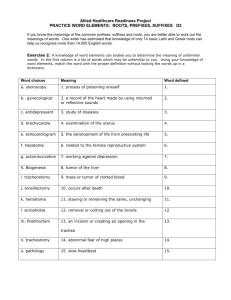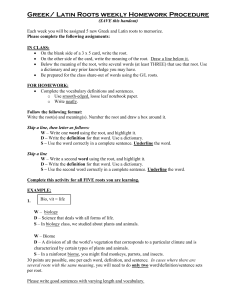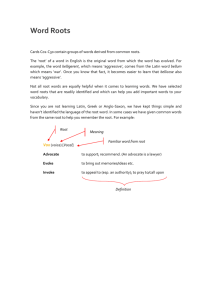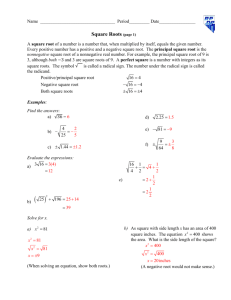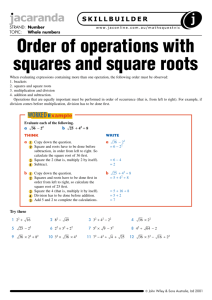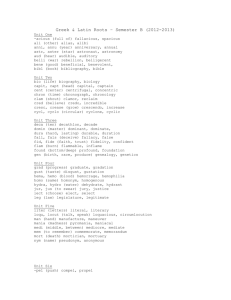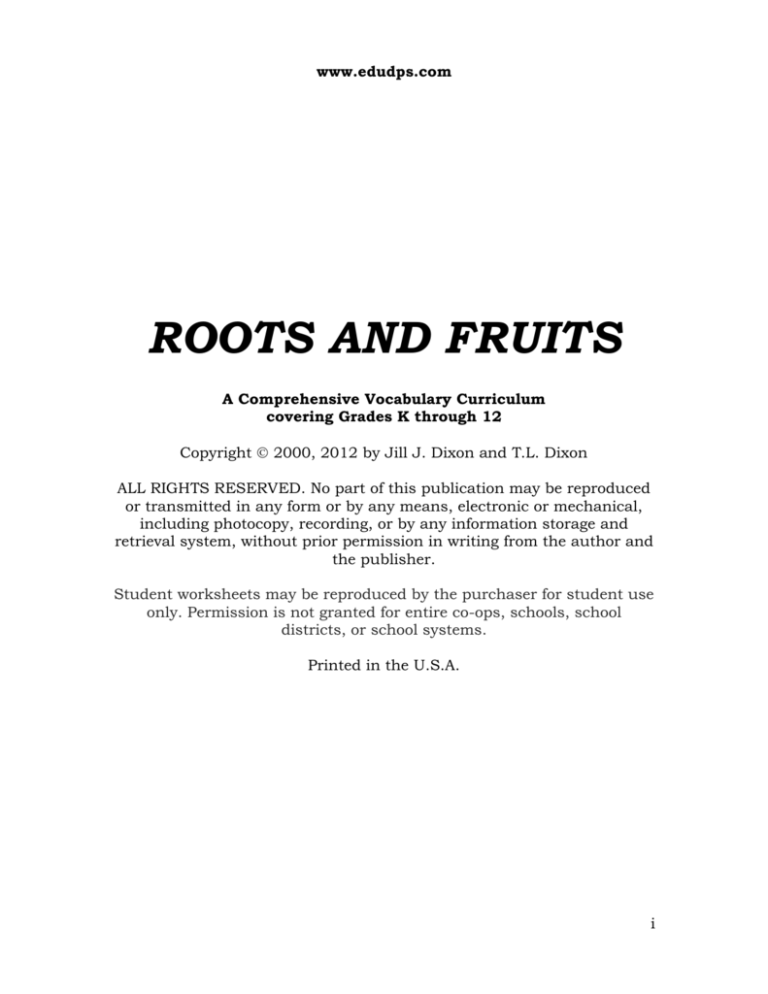
www.edudps.com
ROOTS AND FRUITS
A Comprehensive Vocabulary Curriculum
covering Grades K through 12
Copyright 2000, 2012 by Jill J. Dixon and T.L. Dixon
ALL RIGHTS RESERVED. No part of this publication may be reproduced
or transmitted in any form or by any means, electronic or mechanical,
including photocopy, recording, or by any information storage and
retrieval system, without prior permission in writing from the author and
the publisher.
Student worksheets may be reproduced by the purchaser for student use
only. Permission is not granted for entire co-ops, schools, school
districts, or school systems.
Printed in the U.S.A.
i
www.edudps.com
TABLE OF CONTENTS
Page
Author’s Biographical Information
iii
Introduction
iv
What Is Unique About This Program?
vi
How to Use This Program
viii
Weekly Schedule
xi
Games and Activities
xii / xvii
Roots Alphabetical Listing
1-69
Student Worksheets
70-85
ROOTS ALPHABETICAL LISTING:
Letter
Page
A ...............1
B ...............6
C ...............8
D...............14
E ...............17
F ...............19
G...............23
H...............25
Letter
Page
I ............... 27
J............... 29
K .............. 31
L............... 32
M.............. 35
N .............. 40
O .............. 42
P............... 44
Letter
Page
Q .............. 51
R............... 52
S ............... 54
T ............... 61
U .............. 65
V ............... 66
Z ............... 69
STUDENT WORKSHEETS:
Animal Analysis .................... 70
Cinquain Poetry .................... 71
Dizzy Dialogue....................... 72
Drawing Words...................... 73
Fill in the Blanks ................... 74
Friendly Letter ....................... 75
Newspaper Headlines ............ 76
Parts of Speech ..................... 77
Rhyming Clues ......................78
Root Building Blocks .............79
Roses Are Red .......................80
Same and Different................81
Silly Spiral.............................82
Synonym Spiral .....................83
Vocabulary Cartoon Wheel ....84
Word Association ...................85
ii
www.edudps.com
AUTHOR'S BIOGRAPHICAL INFORMATION
Jill J. Dixon is a homeschooling mother of four, with two now college
graduates. She has homeschooled for nineteen years and taught and
evaluated children for twenty-nine years. Her teaching experience
includes ten years in public school and several years in private school
education, including the teaching of the learning disabled and
emotionally, physically and mentally handicapped. She has a Bachelor of
Science degree in English Education [magna cum laude] and a Master's
of Education degree in Special Education [summa cum laude]. She is the
published author of numerous titles including educational guides,
diagnostic tests, a learning styles assessment, a college and career guide,
and a bestselling vocabulary and writing curriculum. Jill founded Jill
Dixon's Eclectic Academy of Learning in 1998 for homeschooled students
in her home town, and she has spent the last thirteen years teaching and
refining the curriculum so that it can be utilized globally by
homeschoolers in other locales. The Academy has served over 200
children in its operation since 1998. Jill also conducts workshops,
speaks at homeschool conferences, contributes articles to homeschooling
publications, and is a consultant for Homeschool Legal Defense
Association. Jill teaches high school literature and writing at the local
Eclectic Academy of Learning, which presently serves 75 students in
grades 4-12.
To contact her, email
contact@edudps.com
iii
www.edudps.com
INTRODUCTION
This vocabulary curriculum was devised as a result of two
observations in my teaching career. The first one involves my experience
as a Middle School and High School teacher, and the second one is based
on the teaching of my own children.
Several years ago, while working in a College Prepatory
Middle/High School, I was surprised by the poor vocabulary skills of my
students. I realized that even though their reading had been extensive,
they still did not have an extensive vocabulary, meaning that they did not
know what words meant or how to use them. This, in turn, affected every
subject area including math, science, history, and reading
comprehension. Sadly enough, when it came time to take the SAT
(Scholastic Aptitude Test) in eleventh grade, there was no way they were
able to learn the meanings of 500 words that would make up threefourths of the verbal section of that test. I then began to question why
vocabulary study was not introduced into the school curriculum until
eighth grade. Even when it was introduced, words were taught in
isolation so that students forgot them as soon as they took a test. I did
some research and realized that the best way to teach vocabulary was
through teaching the meanings of Greek and Latin roots and prefixes
from which most of our English words derive. I then decided to use this
method with my own children (ages five and seven at the time) whom I
was homeschooling. I started out with simple roots that they could read.
My five year old was an early reader. I introduced one new root a week
and tried to use roots that could be combined with other roots to form
words such as tele and scope. The results were phenomenal. Not only did
my children learn new vocabulary words and how to use them, but their
reading skills also improved immensely by learning to decode multisyllabic words and by reading Greek and Latin roots. We also added
iv
www.edudps.com
these roots and words to our weekly spelling list, and their spelling skills
improved.
Those two children have now gone on to graduate from
homeschooling and from college. Both were honors college graduates.
They and several of my former students tell me that learning these roots
helped them tremendously in their college studies and beyond. My
daughter was actually a foreign language major, and my son was able to
excel in Greek in High School. They both benefited greatly from their
vocabulary studies.
One concern I have had in my observation of homeschooled
children has been a weakness in understanding vocabulary, even though
many have been voracious readers. I have seen many eight-year-old
homeschoolers read on an eighth grade level, yet not comprehend much
of what they have read because of poor vocabulary skills. If someone is
an avid reader, that does not necessarily mean he also has an adequate
vocabulary. The importance of an adequate vocabulary should not be
underestimated. It is essential for understanding various subjects that
enable us to function in our society today.
This program is designed to help you increase the vocabulary,
reading, and spelling skills of your students in just 15 minutes a day.
The games and activities have been used by my own children and other
homeschooled children I teach. They are also designed to meet the needs
of all learners – visual, auditory, and tactile/kinesthetic. You can pick
out the games and activities that best suit the needs of your
child/children. Once I helped a twelfth grade homeschooled student
prepare some essays to send to colleges for admission (including Harvard
and Vanderbilt). She had a very high SAT score, and I asked her why she
thought she did so well on the verbal part of the test. She said that
learning the meaning of Latin roots is what helped her understand SAT
vocabulary. Whether you are preparing your children for future living
v
www.edudps.com
and learning or for future tests, they will certainly benefit from
vocabulary study through learning these roots and prefixes.
WHAT IS UNIQUE ABOUT THIS PROGRAM?
1. Most vocabulary programs teach words in isolation, either by
assigning random lists or in conjunction with a story or book.
Students often forget the meanings once the words are no longer
used. Roots and Fruits emphasizes English forms of Greek and Latin
roots and prefixes from which 80 percent of our language is derived.
Because students learn English roots and prefixes they frequently see
in the words they read and see, they not only remember the meanings
of new words, but are also able to determine meanings of words they
have never seen. Similar programs teach the actual Greek and Latin
roots which are often difficult for children to read and understand
unless they have had extensive Greek and Latin study.
2. Most vocabulary programs do not start until middle school. Several
years have been missed by this time. There are no programs available
that start vocabulary enrichment at the kindergarten level.
3. Other “root” programs offer limited roots. Roots and Fruits offers a
thorough list of 797 roots and prefixes with their meanings and 2,449
vocabulary words, as well as teaching activities, games, complete
lesson plans, and daily worksheets designed for the three primary
learning styles. Roots for elementary students are differentiated from
middle and high school students. This one program can be used with
all your children.
vi
www.edudps.com
4. By beginning vocabulary instruction as early as kindergarten,
students are able to grasp concepts in the other disciplines of math,
science, history, literature, and foreign language because they have
been introduced to the vocabulary ahead of time. Vocabulary skills
are crucial for the understanding of all academic subjects.
5. Students learn dictionary skills by a “hands-on” method instead of by
filling in workbook pages. (One activity utilized in Roots and Fruits is
the use of the dictionary to determine the origin of roots and prefixes.)
6. Many of the example words listed are tested on either the SAT or ACT
college entrance exams and yearly standardized tests. Roots and
Fruits contains the most commonly tested words on the SAT. These
words are in italics and underlined.
vii
www.edudps.com
HOW TO USE THIS PROGRAM
1. I recommend An American Dictionary of the English Language by Noah
Webster or The Oxford Universal Dictionary, for those who desire hard
copies. These have sample sentences for your words and also give the
history of some words and tell whether they derive from Greek or
Latin. There are also several excellent online dictionaries that give
synonyms and very good sentence samples. The best can be found at
dictionary.com, dictionary30.com, and nhd.heinle.com. Younger
students in grades K-4 can start off with a children's dictionary until
they become accustomed to using the dictionary. Many children's
dictionaries, however, do not contain all words, synonyms, or
sentences samples, but they will introduce students to dictionary
skills.
2. For younger students in grades K through 3, you may want to start
with just one (1) root per week at first. All roots and root groups for
this age group are marked with an asterisk (*) and have been chosen
so that they can be used with other roots marked with an asterisk. If
the corresponding vocabulary words are too difficult, you can easily
find less difficult ones in the dictionary. Use your judgment to decide
how many vocabulary words to introduce each week and which ones
you want to use as spelling words. Younger students should at least
be required to spell the new roots. This will aid in increasing spelling
skills. As your child progresses, increase the roots to two (2) per week.
viii
www.edudps.com
3. Older students in grades 4 through 12 should be given two (2) roots a
week with vocabulary words. Again, use your judgment about which
ones and how many vocabulary words to give to each student. If you
desire more vocabulary words, refer to the dictionary. Decide which
ones will be used for spelling. For older students (in grades 8 and
above) just beginning this program, you may want to introduce 3-4
new roots a week so that all the roots and words can be mastered by
the end of high school. Definitely focus on the ones that are in italics
and underlined.
4. Make sure you keep previous roots posted so that at least some can
be reviewed weekly. This insures long-term retention of all the roots.
Require students to review corresponding vocabulary words and their
meanings when reviewing the roots.
5. At the end of each month or four-week segment, you may want to
devise a written test for your students to evaluate their retention and
use of both the roots and words. A matching test works well with the
roots and their meanings and fill-in-the-blank sentences are effective
for determining if your students can use the vocabulary words in a
sentence. However, you can use many of the activities and games
listed to help you do monthly evaluations.
6. Encourage your students to use vocabulary words in weekly writing
assignments. You can work out a reward system for the number of
words used, etc.
ix
www.edudps.com
7. In choosing roots weekly, teachers can group roots in categories if
they choose. Some of the categories are:
a) roots that deal with body parts
b) roots that mean "sleep"
c) roots with number meanings
d) roots that connote action
e) roots with medical meanings
f) roots with scientific meanings
g) roots that mean "water" or things related to water
These are just a few examples.
8. Older students who are preparing for the SAT or ACT should save
their index cards or notebooks with their words and meanings so that
they can review these before taking their test. There are several
expensive programs with SAT vocabulary flashcards, but Roots and
Fruits provides this same service.
9. Try to choose activities and methods that appeal to your student's
specific learning style or strength. If he is visual, write words and
roots in red or highlight with bright highlighters. If auditory, have
him make up songs, raps, rhymes, riddles, and poems to help
remember roots and word meanings. If solely tactile-kinesthetic, your
student will need to play games to retain information and will benefit
from typing out roots and words on the computer. For students with
visual processing problems or dyslexia, always write the roots and
words in red for better visual discrimination. Also note that children
with reading and spelling difficulties can greatly benefit from learning
the roots and corresponding words. Tutors have told me that they
have successfully used Roots and Fruits with their students to
remediate reading and spelling.
x
www.edudps.com
Friday:
Tuesday:
Wednesday:
Thursday:
Monday:
WEEKLY SCHEDULE
1. Write the roots or prefixes and vocabulary words on a large
piece of chart paper or dry erase board, preferably with a
wide red marker. (Note: It is very important that the roots
and words be displayed where they can be seen daily.)
2. Introduce new roots and meanings, and discuss their
meanings.
3. Have each student read all of the roots and vocabulary
words. (Reviewing sample sentences is helpful for
comprehension.)
4. Assist younger students in looking up the vocabulary words
in the dictionary and finding their meanings. Students
should write 2 - 3 synonyms for each word when possible.
Older students can do this on their own. Each root and
vocabulary word with meanings should be written on spiral
index cards or kept in a notebook. When a word has more
than one meaning, you can choose whether to require the
learning of all meanings or just one. I recommend that all
meanings be taught, especially for older students.
5. Optional: Identify whether the root or prefix is Greek or Latin
from the dictionary. If it is Greek, write a G and if it is Latin,
write an L on the card next to the root or prefix.
6. Determine the part of speech of each vocabulary word from
the dictionary and write this on the front of each card next to
the word.
1.
2.
3.
4.
Review the roots, meanings, and vocabulary words.
Have the students read them out loud.
Older students can also review their note cards.
Each student should give a sentence with one or two of the
vocabulary words. See sample sentences to make sure you
are on the right track. Use different words each day.
5. Choose one or two activities, games, or worksheets each day.
1. Students are required to use each word in a sentence.
Two or more words may be used in one sentence as long as
the words are used appropriately. This may be done orally or
by writing. Previous sentences (i.e., of Tuesday through
Thursday) may not be used.
2. Optional: Use one of the games or activities to evaluate your
student's knowledge for the week.
xi
www.edudps.com
GAMES AND ACTIVITIES
Please note that not all activities will appeal to middle and high school
students. Choose appropriate games and activities for each age level.
1.
Silly Sentences: Using your weekly vocabulary words, write a silly
sentence that makes sense. Try to use as many words as you can
and, even better, use words from previous weeks.
Example: Using the roots act, amb, and ambul and the vocabulary
words, you could write this sentence: The siren in the ambulance
was activated by the active boy who ambled into the vehicle.
2.
Silly Sentence Art: If working with two or more children, have the
students exchange silly sentences and require them to draw pictures
to illustrate the sentences they are given. If there is only one child,
the parent can write the silly sentence and have the child illustrate
it.
3.
Silly Sentence Drama: (a) Give the student a silly sentence and
have him act it out. (b) Have the students come up with their own
silly sentences from that week’s vocabulary words. Then ask each
student to act out his sentence. The other students must guess
which vocabulary words and roots he is using. Parents and children
can also do this together.
4.
Beat The Clock: Give each child one root or prefix and see who can
write the most vocabulary words in an allotted time (2-5 minutes). A
kitchen timer works great for this activity.
xii
www.edudps.com
5.
Matching: Choose three (3) roots and write them on separate index
cards two times each. (You will have 6 index cards with one (1) root
written on each card.) Then pick two (2) vocabulary words for each
root and write these on six (6) separate cards. Altogether you will
have 12 index cards. Mix the cards up and place them face down on
the table. Each person takes turns matching a root with a
vocabulary word. The person with the most matches wins. You can
also require each child to give the meaning of the root and to use the
corresponding vocabulary word in a sentence in order to win the
game.
6.
Word Maker: Write 4 or more roots on index cards. Use one card per
root. (Using many roots is best for this game.) Place them face up on
the table. Mix and match to form words. For example: tele and photo
could make the word telephoto.
7.
Back Trace: Take turns writing (tracing) roots on each other’s
backs. Guess the root and tell the meaning.
8.
Trick Sentences: While looking at a chart of roots and vocabulary
words, the teacher gives a sentence with an incorrect word. The
students must replace the sentence with the correct vocabulary
word. Another variation of this game is to give correct and incorrect
sentences and have the students decide when the word is used
correctly and incorrectly.
9.
Twenty Questions: One person picks a vocabulary word from the
posted chart. The other players get to ask up to 20 questions each to
determine what the word is. Only questions can be asked and the
person who picks the word can only respond with yes or no.
xiii
www.edudps.com
10. Draw A Stick Man: Using the same steps from the old game “Hang
Man”, choose a word from the vocabulary word list and have the
other players guess the letters to complete the word. Make sure the
meaning of the vocabulary word is discussed. To complete the win
(when all letters are placed before the man is finished), the players
must give the root of the word.
11. Jell-O Writing: Using dry Jell-O with a few drops of water as paint,
practice writing roots and vocabulary words on white paper. You
can also use chocolate pudding or shaving cream for this.
12. Rooty Fruity Scrabble: Using a real Scrabble game, give a list of
roots and vocabulary words to each player. Each player receives
points for each root or vocabulary word made.
13. Root or Word Bingo: Take a blank sheet of paper and divide it into
16 squares. You can do this by folding the paper 4 times. Put a root
and/or vocabulary word in each square. Call out the meaning and
have the students place a game piece (you can use paper squares,
cereal, or candy pieces) on the correct word or root.
14. Riddle Game: The teacher chooses an example word and gives clues
in riddle form to help the students guess the word. For example: “I
am a word that shows action”, “I am a word that people use when
talking about animals.”
15. Fill in the Blank: Make a list of vocabulary words. Pick sample
sentences from a dictionary. Read the sample sentence to students,
leaving out the vocabulary words. Have students fill in the blanks.
xiv
www.edudps.com
ROOT OR PREFIX
MEANING
VOCABULARY
A
*a
on
a
not
* ab
abs
a
away from
acr
acu
sharp, sour
* act
do
* ad
a
ac
to
toward
aer
aero
air
aesthet
sense
Diagnostic Prescriptive Services
aboard
afire
aground
amoral
anomaly
apathy
atheist
atrophy
atypical
abdicate
abhor
abstain
abstract
absurd , avert
acrid
acrimonious
acrimony, acuity
acumen
acupuncture
acute
action
activate
activism
enact
abet
accelerate
accolade
adage
addict, adulterate
affable , allure
aerial
aerobics
aeronautics
aesthete
aesthetic
aesthetically
1
www.edudps.com
ROOT OR PREFIX
MEANING
af
to
ag
to
to add to
* agon
contest
struggle
agr
agri
field
ali
altr
another
alter
other
ambi
both
* amb
ambul
walk
ami
amo
love
amp
large
amphi
both
an
not
Diagnostic Prescriptive Services
VOCABULARY
affirm,
affiliate,
affix
aggravate
aggregate
aggression
agony
antagonist
antagonize
protagonist
agrarian
agribusiness
agriculture
agronomy
alias
alienate
altruism
alter
alternate
alternative
ambidextrous
ambiguous
ambivalent
amble
ambulance
ambulatory
amiable
amicable
amity
amorous
ample
amplify
amplitude
amply
amphibian
amphibious
anarchy
anemia
anorexia
2
www.edudps.com
ROOT OR PREFIX
MEANING
an
to
toward
ana
up
back
again
* andro
man
* ang
bend
* anim
life
spirit
soul
* ann
enn
year
ante
anti
before
anthrop
human
* ant
anti
against
apt
ept
suitable
* aqua
aque
water
Diagnostic Prescriptive Services
VOCABULARY
annex
announce
annul
annulment
Anabaptism
Anabaptist
anatomy
android
androgen
angular
triangle
quadrangle
animate
animism
animosity
inanimate
magnanimous
annual
annuity
biennial
antecedent
antiquated
antiquity
anthropology
anthropomorphism
misanthrope
antagonist
antibiotics
antipathy
antislavery
antisocial
adept
aptitude
inept
ineptitude
aquanaut
aquatic
aqueduct
aqueous
3
www.edudps.com
ROOT OR PREFIX
MEANING
arbit
judge
arbor
tree
* arch
ap
chief
first
beginning
archae
arch
ancient
primitive
aristo
upper class
arm
weapons
equipment
hostility
* art
ert
skill
art
artic
joint
division
as
to
* ast
astro
star
Diagnostic Prescriptive Services
VOCABULARY
arbiter
arbitrary
arbitration
arbitrator
arboreal
arboretum
arborist
apex
archbishop
archenemy
monarchy
archaeology
archaic
archive
aristocracy
aristocrat
aristocratic
arm
armament
armature
armistice
disarmament
disarming
artifact
artifice
artisan
inert
inertia
article
articulate
articulation
ascertain
aspire
assimilate
assume
asterisk
astronomer
astronomical
astronomy
4
www.edudps.com
ROOT OR PREFIX
MEANING
alt
high
* aud
hear
auda
to be bold
to dare
auster
harsh
* auto
self
ava
avi
to covet
(greed)
Diagnostic Prescriptive Services
VOCABULARY
altimeter
altitude
alto
audible
audience
audit
audition
auditory
inaudible
audacious
audacity
austere
austerity
autobiography
automaton
automobile
autonomy
avarice
avaricious
avid
5


